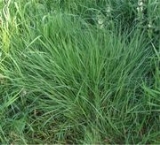
Agrostis capillaris
Encyclopedia
Agrostis capillaris is a rhizomatous and stoloniferous perennial in the grass family (Poaceae
). It is native to Eurasia
and has been widely introduced in many parts of the world. Colonial bent grows in moist grasslands and open meadows, and can also be found in agricultural areas, roadsides, and invading disturbed areas.
The name agrostis
comes from the Greek
word meaning forage
plant, agros meaning 'a field'.
It is found growing in neutral to acidic soils. It has a very fine texture and like most bent grasses grows very dense. Although this species has been used on golf courses and sporting fields it is better suited for lawns. Colonial Bent is fairly easy to grow from seeds and fertilization of the lawn is not as intense. This grass also takes longer to establish than Creeping Bent. However it does not require the intense maintenance.
Many internet sources describe it as being the tallest of the bent species. However C E Hubbard describes its height as ranging from 10 to 70cm high, whereas the Black Bent Agrostis gigantea
is 40 to 120 cm. Marjorie Blamey, Richard and Alastair Fitter also describe Black Bent as being taller.
is short and does not come to a point. This differs from Creeping Bent, Agrostis stolonifera
which is pointed and up to 5mm long.
The flowering panicle
s appear from May until June. They are finely branched and look like a purple haze from a distance. The panicle persists in winter after the seeds have been shed.
Poaceae
The Poaceae is a large and nearly ubiquitous family of flowering plants. Members of this family are commonly called grasses, although the term "grass" is also applied to plants that are not in the Poaceae lineage, including the rushes and sedges...
). It is native to Eurasia
Eurasia
Eurasia is a continent or supercontinent comprising the traditional continents of Europe and Asia ; covering about 52,990,000 km2 or about 10.6% of the Earth's surface located primarily in the eastern and northern hemispheres...
and has been widely introduced in many parts of the world. Colonial bent grows in moist grasslands and open meadows, and can also be found in agricultural areas, roadsides, and invading disturbed areas.
The name agrostis
Agrostis
Agrostis is a genus of over 100 species belonging to the grass family Poaceae, commonly referred to as the bent grasses...
comes from the Greek
Greek language
Greek is an independent branch of the Indo-European family of languages. Native to the southern Balkans, it has the longest documented history of any Indo-European language, spanning 34 centuries of written records. Its writing system has been the Greek alphabet for the majority of its history;...
word meaning forage
Forage
Forage is plant material eaten by grazing livestock.Historically the term forage has meant only plants eaten by the animals directly as pasture, crop residue, or immature cereal crops, but it is also used more loosely to include similar plants cut for fodder and carried to the animals, especially...
plant, agros meaning 'a field'.
It is found growing in neutral to acidic soils. It has a very fine texture and like most bent grasses grows very dense. Although this species has been used on golf courses and sporting fields it is better suited for lawns. Colonial Bent is fairly easy to grow from seeds and fertilization of the lawn is not as intense. This grass also takes longer to establish than Creeping Bent. However it does not require the intense maintenance.
Many internet sources describe it as being the tallest of the bent species. However C E Hubbard describes its height as ranging from 10 to 70cm high, whereas the Black Bent Agrostis gigantea
Agrostis gigantea
Agrostis gigantea, known by its common name Redtop, is a perennial grass of the Agrostis genus.It is native to Europe, but in the cooler areas of North America was widely used as a pasture grass until the 1940s. Although it has largely been replaced by soybeans and more palatable grasses, it still...
is 40 to 120 cm. Marjorie Blamey, Richard and Alastair Fitter also describe Black Bent as being taller.
Physical description
It forms a dense sward of fine leaves. The liguleLigule
A ligule — is a thin outgrowth at the junction of leaf and leafstalk of many grasses and sedges or a strap-shaped corolla, such as that of a ray floret in plants in the daisy family....
is short and does not come to a point. This differs from Creeping Bent, Agrostis stolonifera
Agrostis stolonifera
Agrostis stolonifera is a perennial grass species in the Poaceae family. It is stoloniferous and may form mats or tufts...
which is pointed and up to 5mm long.
The flowering panicle
Panicle
A panicle is a compound raceme, a loose, much-branched indeterminate inflorescence with pedicellate flowers attached along the secondary branches; in other words, a branched cluster of flowers in which the branches are racemes....
s appear from May until June. They are finely branched and look like a purple haze from a distance. The panicle persists in winter after the seeds have been shed.
External links
- Garden Organic Website for a detailed description

